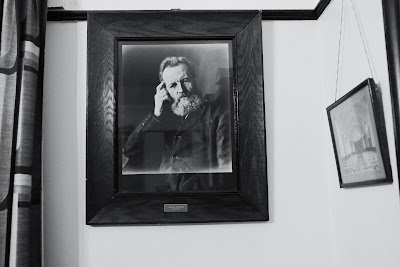An unexpected, direct link between Shin Buddhism and the Cambridge Unitarian Church
 |
| J. Estlin Carpenter’s picture in the Cambridge Unitarian Church |
“Today, I read Tannisho. If I had known about the Buddhist monk Shinran a decade ago, I wouldn’t have studied Greek and Latin but Japanese so as to learn and spread the teachings of him for a lifetime. But it’s too late.”
(Can anyone out there provide a proper source for this quote? I’d be very grateful).
It is these (and other) philosophical/religious links that drew me to study Shin (at least as it is understood by the Higashi school). Along the way, as you also now know, I’ve noticed lots of relationships that exist between Shin and liberal protestant, Unitarian and Universalist Christianity — and that’s why I’ve suggested introducing you to the Tannisho, a key text of this Shin (particularly for the modern Higashi school).
OK. But, yesterday and today (thanks to the bad weather), I’ve been inside a lot and had the chance to read and watch a few lectures by Mark Blum, a scholar who has done a lot of work on thinkers of the Higashi branch of Jodō Shinshū. One of the things he said was that because the school pursued a critical approach to their Buddhist tradition, a number of Higashi scholars went to Oxford to study Sanskrit and Pali under Max Müller so as to be able to study the very earliest Buddhist texts that, until then, had been pretty much ignored in Japan. One of the important scholars connected with Müller in Oxford was J. Estlin Carpenter (1844–1927) who was an English Unitarian minister and principal of Manchester College, Oxford (the college where I studied theology and trained for the ministry). But he was also an expert in Sanskrit as well as being a pioneer in the study of comparative religion.
Some of you may already know that Carpenter’s picture hangs in our church Common Room because it was thanks to a series of lectures by him here in Cambridge, plus his general, ongoing encouragement, that the Cambridge Church formally became a congregation in 1904 and then built the hall and church in 1923 and 1927 respectively. Indeed, as a thank you to him, our church hall was until fairly recently known around town as “Carpenter Hall.” The name was only changed because people who wanted to hire our hall kept trying to look up the “Unitarian Hall” in the telephone directory and couldn’t find it.
Anyway, the Higashi/Müller/Carpenter connection suddenly made me realise I needed to check out Carpenter’s book on Buddhism and Christianity and also his various essays published in our denomination’s once globally famous journal, “The Hibbert Journal” (of which we have a complete set in the Common Room).
And, yes, you've guessed it — Shin figures in his work in some prominent and important ways. He, too, sees lots of really interesting and fruitful connections between Shin Buddhism and liberal Christianity/Unitarian Christianity. Now I’ll dig into this properly over the next few months but I’ll leave you with one quote from Carpenter that will, I hope, reveal that my own intuitions about the value of Shin Buddhism to us today are neither far-fetched nor unduly eccentric! In fact, it turns out that I simply seem to be walking a path that has already been explored by our own religious tradition, even if only as a “road less travelled by.” But, just perhaps (à la Robert Frost) it will turn out to be the path that makes all the difference. Let’s see . . .
So, in the essay “Religion in Further East” (Hibbert Journal, Vol. VII, No. 3, p. 46) Carpenter writes:
“It will be to the lasting shame of Christian sectarianism if the Buddhism that expresses itself thus [i.e. Shin Buddhism as expressed by Tada Kanai from the Higashi school] remains estranged from the character and the message of Jesus Christ.”
Intriguing, eh? . . .


Comments